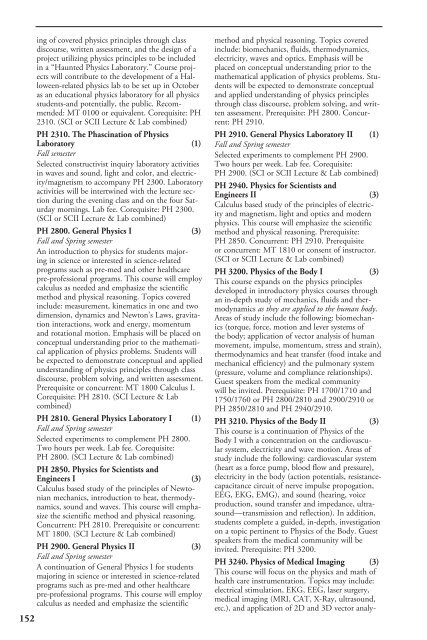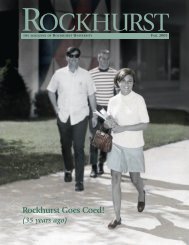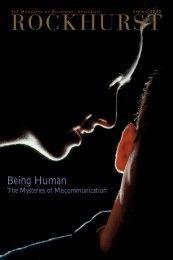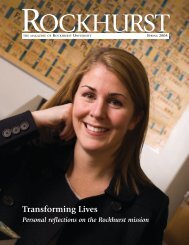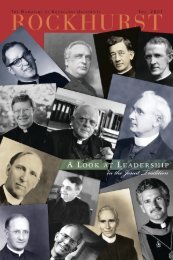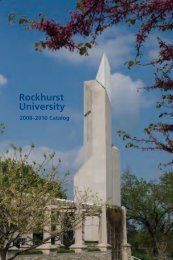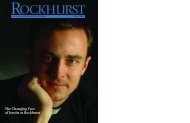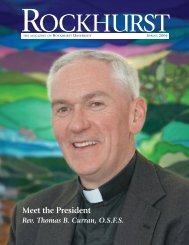RockhuRst univeRsity 2012â2014 catalog
RockhuRst univeRsity 2012â2014 catalog
RockhuRst univeRsity 2012â2014 catalog
- No tags were found...
Create successful ePaper yourself
Turn your PDF publications into a flip-book with our unique Google optimized e-Paper software.
152ing of covered physics principles through classdiscourse, written assessment, and the design of aproject utilizing physics principles to be includedin a “Haunted Physics Laboratory.” Course projectswill contribute to the development of a Halloween-relatedphysics lab to be set up in Octoberas an educational physics laboratory for all physicsstudents-and potentially, the public. Recommended:MT 0100 or equivalent. Corequisite: PH2310. (SCI or SCII Lecture & Lab combined)PH 2310. The Phascination of PhysicsLaboratory (1)Fall semesterSelected constructivist inquiry laboratory activitiesin waves and sound, light and color, and electricity/magnetismto accompany PH 2300. Laboratoryactivities will be intertwined with the lecture sectionduring the evening class and on the four Saturdaymornings. Lab fee. Corequisite: PH 2300.(SCI or SCII Lecture & Lab combined)PH 2800. General Physics I (3)Fall and Spring semesterAn introduction to physics for students majoringin science or interested in science-relatedprograms such as pre-med and other healthcarepre-professional programs. This course will employcalculus as needed and emphasize the scientificmethod and physical reasoning. Topics coveredinclude: measurement, kinematics in one and twodimension, dynamics and Newton’s Laws, gravitationinteractions, work and energy, momentumand rotational motion. Emphasis will be placed onconceptual understanding prior to the mathematicalapplication of physics problems. Students willbe expected to demonstrate conceptual and appliedunderstanding of physics principles through classdiscourse, problem solving, and written assessment.Prerequisite or concurrent: MT 1800 Calculus I.Corequisite: PH 2810. (SCI Lecture & Labcombined)PH 2810. General Physics Laboratory I (1)Fall and Spring semesterSelected experiments to complement PH 2800.Two hours per week. Lab fee. Corequisite:PH 2800. (SCI Lecture & Lab combined)PH 2850. Physics for Scientists andEngineers I (3)Calculus based study of the principles of Newtonianmechanics, introduction to heat, thermodynamics,sound and waves. This course will emphasizethe scientific method and physical reasoning.Concurrent: PH 2810. Prerequisite or concurrent:MT 1800. (SCI Lecture & Lab combined)PH 2900. General Physics II (3)Fall and Spring semesterA continuation of General Physics I for studentsmajoring in science or interested in science-relatedprograms such as pre-med and other healthcarepre-professional programs. This course will employcalculus as needed and emphasize the scientificmethod and physical reasoning. Topics coveredinclude: biomechanics, fluids, thermodynamics,electricity, waves and optics. Emphasis will beplaced on conceptual understanding prior to themathematical application of physics problems. Studentswill be expected to demonstrate conceptualand applied understanding of physics principlesthrough class discourse, problem solving, and writtenassessment. Prerequisite: PH 2800. Concurrent:PH 2910.PH 2910. General Physics Laboratory II (1)Fall and Spring semesterSelected experiments to complement PH 2900.Two hours per week. Lab fee. Corequisite:PH 2900. (SCI or SCII Lecture & Lab combined)PH 2940. Physics for Scientists andEngineers II (3)Calculus based study of the principles of electricityand magnetism, light and optics and modernphysics. This course will emphasize the scientificmethod and physical reasoning. Prerequisite:PH 2850. Concurrent: PH 2910. Prerequisiteor concurrent: MT 1810 or consent of instructor.(SCI or SCII Lecture & Lab combined)PH 3200. Physics of the Body I (3)This course expands on the physics principlesdeveloped in introductory physics courses throughan in-depth study of mechanics, fluids and thermodynamicsas they are applied to the human body.Areas of study include the following: biomechanics(torque, force, motion and lever systems ofthe body; application of vector analysis of humanmovement, impulse, momentum, stress and strain),thermodynamics and heat transfer (food intake andmechanical efficiency) and the pulmonary system(pressure, volume and compliance relationships).Guest speakers from the medical communitywill be invited. Prerequisite: PH 1700/1710 and1750/1760 or PH 2800/2810 and 2900/2910 orPH 2850/2810 and PH 2940/2910.PH 3210. Physics of the Body II (3)This course is a continuation of Physics of theBody I with a concentration on the cardiovascularsystem, electricity and wave motion. Areas ofstudy include the following: cardiovascular system(heart as a force pump, blood flow and pressure),electricity in the body (action potentials, resistancecapacitancecircuit of nerve impulse propogation,EEG, EKG, EMG), and sound (hearing, voiceproduction, sound transfer and impedance, ultrasound—transmissionand reflection). In addition,students complete a guided, in-depth, investigationon a topic pertinent to Physics of the Body. Guestspeakers from the medical community will beinvited. Prerequisite: PH 3200.PH 3240. Physics of Medical Imaging (3)This course will focus on the physics and math ofhealth care instrumentation. Topics may include:electrical stimulation, EKG, EEG, laser surgery,medical imaging (MRI, CAT, X-Ray, ultrasound,etc.), and application of 2D and 3D vector analy-


